Step right up and see the show!
Posted March 2015 in New Additions, Significant Photographs
P.T. Barnum gave me permission. A recent news item that Ringling Bros. and Barnum & Bailey Circus would send their remaining ponderous performing pachyderms to a Florida retirement home by 2018 got me to thinking recently. Did I not possess in my archive one very old mysterious photograph of a stuffed elephant? Sure enough, I did.
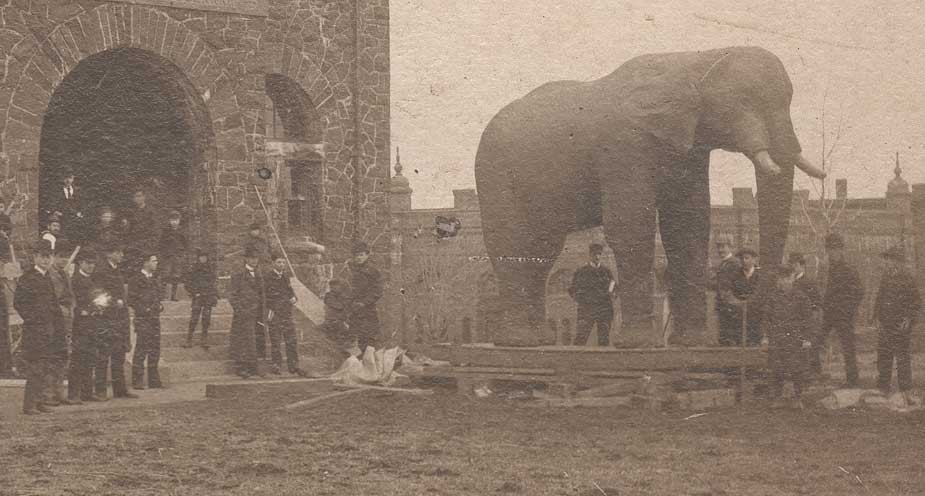 Detail: "Moving Jumbo into Barnum Museum, 1889" (assigned title by Tufts University Archives- see variant:ID: tufts:UA136.002.DO.00823 ): Attributed photographer: Charles Rollins Tucker, American (b. 1868): 1889: mounted brown-toned gelatin silver print on cabinet card: 8.3 x 11.0 cm | 10.8 x 13.2 cm. This rare photograph believed to have been taken on April 3, 1889 posthumously shows the famed circus elephant Jumbo (died 1885) formerly owned by circus showman P.T. Barnum sitting outside the Barnum Museum of Natural History on the Tufts College campus in Medford, Mass. before being placed on display. Vintage photograph from: PhotoSeed Archive.
Detail: "Moving Jumbo into Barnum Museum, 1889" (assigned title by Tufts University Archives- see variant:ID: tufts:UA136.002.DO.00823 ): Attributed photographer: Charles Rollins Tucker, American (b. 1868): 1889: mounted brown-toned gelatin silver print on cabinet card: 8.3 x 11.0 cm | 10.8 x 13.2 cm. This rare photograph believed to have been taken on April 3, 1889 posthumously shows the famed circus elephant Jumbo (died 1885) formerly owned by circus showman P.T. Barnum sitting outside the Barnum Museum of Natural History on the Tufts College campus in Medford, Mass. before being placed on display. Vintage photograph from: PhotoSeed Archive.
Looks kinda important.
Bunch of people standing outside a building… with a really big stuffed elephant.
Now to some Google “research”.
It’s Jumbo!
As in: “Jumbo was the greatest circus attraction in American history.” (1.)
So now I’m more interested in that old photo. But then it dawns on me: several years ago, I had purchased a trove of material taken by an amateur photographer named Charles Rollins Tucker. Never heard of him? Tufts College. Class of 1891. Bachelor of Philosophy with specialties in chemistry and physics, then a Master of Arts from the same institution in 1894. From Stoughton, Massachusetts, Tucker first resided in East Hall (room 26) on the Tufts campus after first matriculating in the Fall of 1887. Trust me. I know a great deal more, and eventually, time willing, you will too. Several photographs of his daughter Dorothy, (also a Tufts graduate) including “Girl with Kodak“ and an earlier study of her photographing her doll have been hiding in plain site on this website for several years now, and I eventually hope to show the progression of her growing up in a wonderful series of images taken by her father.
But now back to the main attraction, that old photograph. Like I said, Barnum would approve.
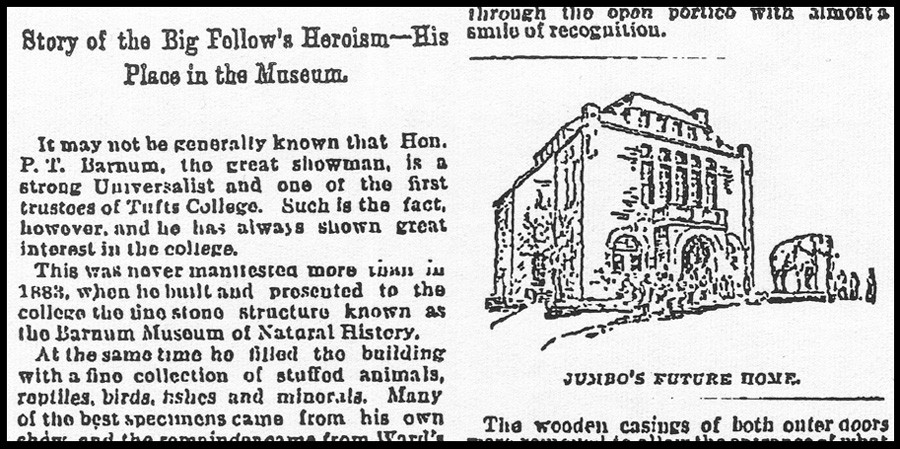 A woodcut taken from the Charles Tucker photograph of Jumbo before being placed on display inside the Barnum Museum of Natural History on the Tufts College campus on April 3, 1889 is one of two accompanying an article written by Tufts graduate and Boston Daily Globe reporter Julien C. Edgerly for the April 4, 1889 edition of the newspaper.
A woodcut taken from the Charles Tucker photograph of Jumbo before being placed on display inside the Barnum Museum of Natural History on the Tufts College campus on April 3, 1889 is one of two accompanying an article written by Tufts graduate and Boston Daily Globe reporter Julien C. Edgerly for the April 4, 1889 edition of the newspaper.
The Particulars
Jumbo, a word synonymous with someone or something very large or huge-especially so in the American lexicon, was an African elephant of immense proportions. According to Wikipedia, he was also the first “international animal superstar” after showman Phineas Taylor Barnum (1810-1891) purchased him from the London Zoo in 1882 for $10,000. However, in September of 1885, after entertaining North American circus audiences for a bit more than 3 years, he came to an inglorious end after being accidentally struck by a freight train after a Canadian performance.
Barnum being Barnum, a little thing like death was certainly not going to get in the way of Jumbo thrilling audiences while continuing to replenish his masters coffers- albeit in a more restrained and static way. An early trustee and munificent benefactor of the school, he gave it $55,000 in 1882 for the establishment of the Barnum Museum of Natural History on the campus, which was completed by 1884. Housing a museum of natural history showcasing a multitude of stuffed circus and zoological animal specimens as well as laboratories and classrooms, arrangements for Jumbo’s remains had been planned even while he was still alive. Overseeing the museum was John Marshall, the first professor of natural history at the school, who had presciently written to Henry A. Ward, Barnum’s taxidermist extraordinaire and owner of the “Natural Science Establishment” in Rochester, N.Y. two weeks before Jumbo’s death:
College Hill. Sep 1. 1885.
Dear Prof. Ward.
We fully expect to have the skin of Jumbo when he dies. Jumbo was excepted when the arrangement was made with the Smithsonian. I should not consider the Barnum Museum complete without this noble animal. It would be the greatest ornament that we could place in the Vestibule, near Mr. Barnum’s bust. Our front door to the Museum is [blank] feet high. You can judge whether the stuffed Jumbo would go in. It is wide enough, I think. Probably it would be necessary to stuff the skin in the vestibule. I have not decided upon the skeleton yet but will endeavor to let you know soon. - I think your offer to Mr. Barnum was $75 in exchange or $50 in money. Would you object to letting the $50 go towards the skulls? -
Yours very truly.
John P. Marshall (2.)
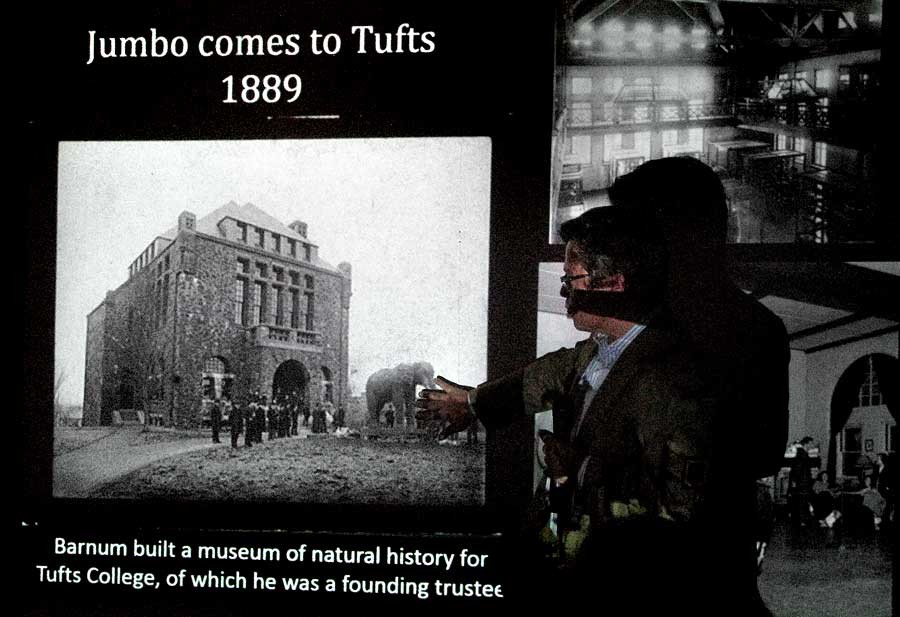 Tufts University Professor of Art History Dr. Andrew McClellan points to the photograph of the stuffed Jumbo before the elephant was placed on display inside the natural history museum on the Tufts campus in 1889 during a public lecture he gave at the Barnum Museum in Bridgeport, CT in April, 2015. In 2014, for the 125th anniversary of the arrival of Jumbo at Tufts, McClellan curated the life story of the famed elephant as part of the exhibit "Jumbo: Marvel, Myth, and Mascot", with the university publishing a pictorial monograph authored by him by the same title. Photo by David Spencer/PhotoSeed Archive
Tufts University Professor of Art History Dr. Andrew McClellan points to the photograph of the stuffed Jumbo before the elephant was placed on display inside the natural history museum on the Tufts campus in 1889 during a public lecture he gave at the Barnum Museum in Bridgeport, CT in April, 2015. In 2014, for the 125th anniversary of the arrival of Jumbo at Tufts, McClellan curated the life story of the famed elephant as part of the exhibit "Jumbo: Marvel, Myth, and Mascot", with the university publishing a pictorial monograph authored by him by the same title. Photo by David Spencer/PhotoSeed Archive
After Jumbo’s demise, Ward was dispatched to Canada in order to secure the animal’s remains, not an easy task. Arriving two days after the accident on Sept. 17, souvenir seekers had to be kept at bay by police:
In addition to the problem of size, Jumbo’s fame caused added complications. Relic seekers had done some damage before Ward arrived, and a policeman had been put on guard to prevent further mutilation. It took Ward, his assistants, and half a dozen butchers from St. Thomas, two days to dissect the elephant and prepare the hide and skeleton for shipment. The hide weighed 1,538 pounds, the bones 2,400 pounds. Coins of many kinds were found in Jumbo’s stomach, and Ward was quoted as having said that “Jumbo was a bank all by himself.” His stomach also contained rivets, a bunch of keys on a ring, a policeman’s whistle, and various ornaments. (3.)
By March of the following year, after his skin had been tanned and “scraped to a uniform thickness and nailed to a huge wooden framework with 74,480 nails”, (4.) Ward’s Natural Science Establishment delivered two finished mounts of Jumbo to Barnum at a reported cost of $1200.00: (5.) one of his skeleton and another for his hide. This stuffed version of Jumbo, after two additional years of touring with The Greatest Show on Earth, eventually made its’ way to Medford and the college via train after Barnum made the decision to (mostly) “retire” him from traveling circus life.
A Rare Survivor
With this mounted cabinet card seemingly the only photographic evidence of his arrival on campus, it must have been quite a sight to see all the steps taken to safely transport Jumbo by train, ferryboat and horse-drawn carriage on his final journey to Tufts. Beginning on Friday, March 29 from his winter home in Bridgeport, CT , Jumbo finally arrived in front of the Barnum museum at the college on Wednesday, April 3, 1889, with the final leg of the journey described as:
…” he was hauled to Tufts by a double team of horses. When that team proved unable to pull him up College Hill, more than 50 Tufts professors and students, aided by some local boys, completed the task.” (6.)
An alternate dispatch from 1888 Tufts graduate Julien C. Edgerly, (1865-1913) a reporter and news editor for the Boston Daily Globe newspaper who witnessed the famed elephants arrival on campus, wrote an article published in the edition for Thursday, April 4, 1889, illustrated by a small woodcut of the mounted cabinet card seen here. Conclusive proof it was taken by Tufts student Charles Rollins Tucker-albeit without being named directly-was included in Edgerly’s article. Some excerpts:
The mounted skin of Jumbo this morning stands in front of the museum on the top of College hill, as shown in the accompanying cuts, one of which shows the animal with a man at his side to give by contrast an idea of his size, and the other shows both Jumbo and the building which, barring the cadence of fortune, is destined to be his last long home. …
After Jumbo made his final journey, pulled by 6 horses up College Hill to the front doors of the Barnum Museum, the carriage he was riding on was “taken apart and drawn away.” … and:
The canvas coverings were removed to allow a student photographer to transfer his image to the plate of the camera. Several views were taken, some with ambitious young men upon the great beast’s back. Then the coverings were replaced and he will stand as lone sentinel till today when he will be placed inside the museum. He will occupy the centre of the large front room, facing the entrance. (7.)
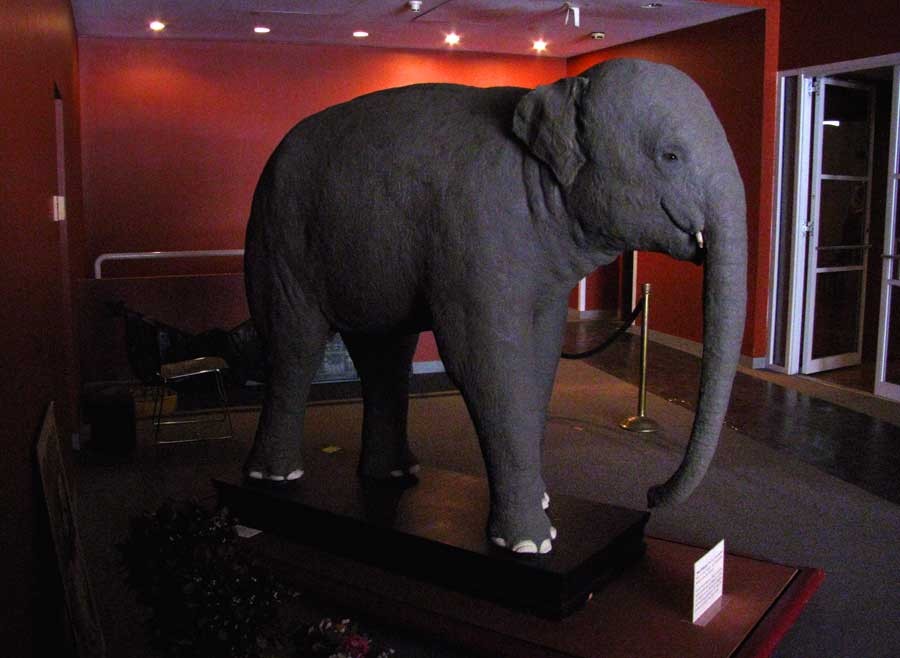 A survivor indeed. Standing nearly 7' and weighing 700 pounds, "Baby Bridgeport" is a preserved Asian elephant that was only the second elephant born in captivity in America owned by P.T. Barnum. Similarly mounted like Jumbo by taxidermist Henry Ward when he died at four years of age in 1886 and originally displayed alongside Jumbo inside the Barnum museum at Tufts in 1889, Baby Bridgeport continues to be a popular attraction for visitors to the Barnum Museum in Bridgeport, CT seen here in April, 2015. Photo by David Spencer/PhotoSeed Archive
A survivor indeed. Standing nearly 7' and weighing 700 pounds, "Baby Bridgeport" is a preserved Asian elephant that was only the second elephant born in captivity in America owned by P.T. Barnum. Similarly mounted like Jumbo by taxidermist Henry Ward when he died at four years of age in 1886 and originally displayed alongside Jumbo inside the Barnum museum at Tufts in 1889, Baby Bridgeport continues to be a popular attraction for visitors to the Barnum Museum in Bridgeport, CT seen here in April, 2015. Photo by David Spencer/PhotoSeed Archive
Professor Marshall, writing in the Annual Report of the President of Tufts College for 1889, also gave an interesting account of Jumbo’s arrival that day, commenting Jumbo had increased visitors to the museum among other observations:
Jumbo was brought to the Barnum Museum on Fast Day of the present year, and moved into the vestibule the following day. All the wood-work was removed from the great arch of the portico, leaving barely room for the entrance of the largest mounted elephant of modern times. It will be taken away, September 20, to be exhibited in London during the coming winter. About the first of April of next year, it will become a permanent attraction of the Museum. During the five months of its exhibition here the number of visitors to the Museum was largely increased. Your attention is again respectfully invited to the need of additional cases for the proper exhibition of specimens which have been accumulating during the past two years.
Respectfully submitted,
JOHN P. MARSHALL,
Director. Tufts College,
September 19, 1889. (8.)
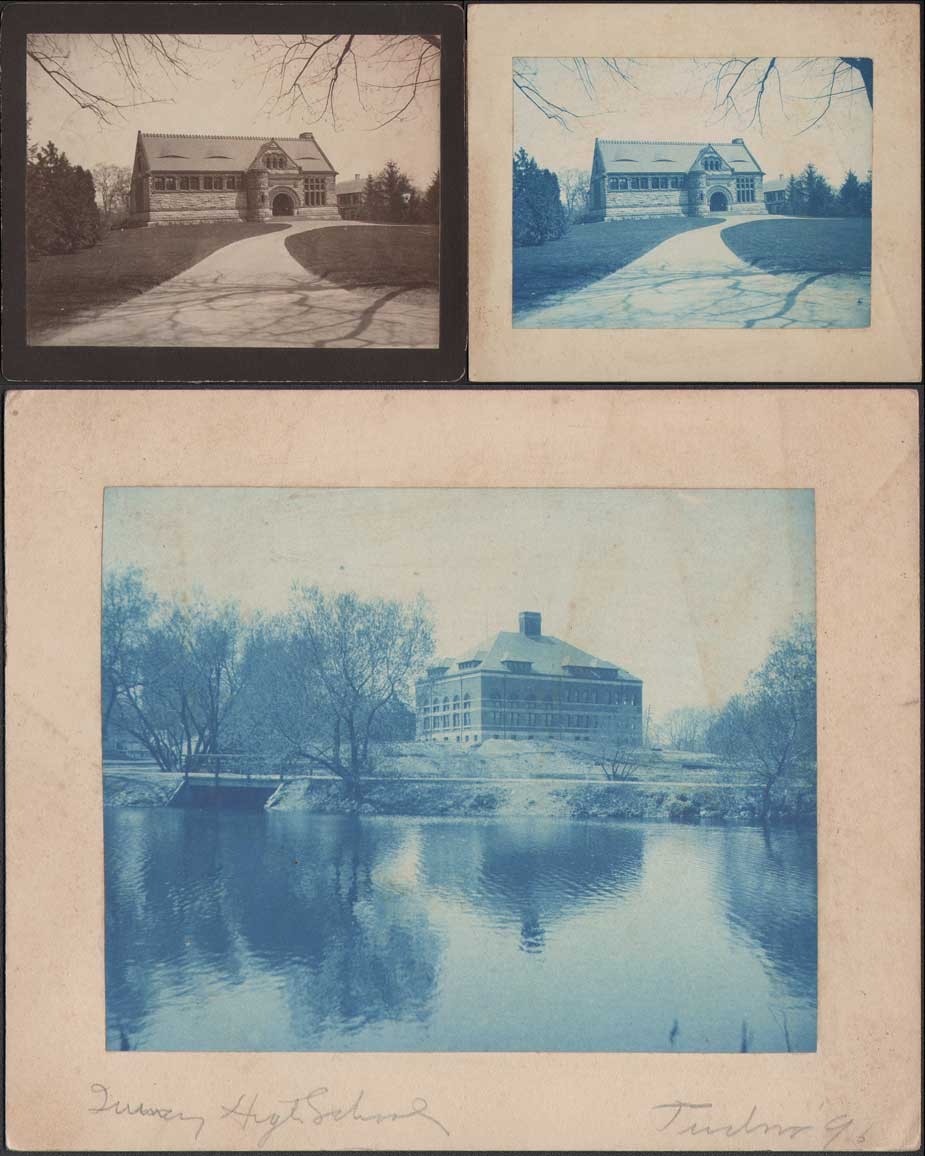 Top left: Exterior entrance view showing the Thomas Crane Public Library (built 1882) by architect Henry Hobson Richardson in Quincy, Mass. : Attributed photographer: Charles Rollins Tucker, American (b. 1868):Vintage brown-toned gelatin silver print on cabinet card: 9.0 x 11.8 cm | 10.8 x 13.2 cm. Top Right: Exterior entrance view showing the Thomas Crane Public Library (built 1882) by architect Henry Hobson Richardson in Quincy, Mass. : Attributed photographer: Charles Rollins Tucker, American (b. 1868): 1896: Vintage cyanotype print on cabinet card: 9.1 x 12.0 cm | 12.7 x 15.2 cm. Bottom: Exterior view of "Quincy High School" with pond in foreground: Signed lower right: "Tucker '96": Charles Rollins Tucker, American (b. 1868):Vintage cyanotype print on cabinet card: 9.4 x 11.9 cm | 12.7 x 15.3 cm. All from: PhotoSeed Archive
Top left: Exterior entrance view showing the Thomas Crane Public Library (built 1882) by architect Henry Hobson Richardson in Quincy, Mass. : Attributed photographer: Charles Rollins Tucker, American (b. 1868):Vintage brown-toned gelatin silver print on cabinet card: 9.0 x 11.8 cm | 10.8 x 13.2 cm. Top Right: Exterior entrance view showing the Thomas Crane Public Library (built 1882) by architect Henry Hobson Richardson in Quincy, Mass. : Attributed photographer: Charles Rollins Tucker, American (b. 1868): 1896: Vintage cyanotype print on cabinet card: 9.1 x 12.0 cm | 12.7 x 15.2 cm. Bottom: Exterior view of "Quincy High School" with pond in foreground: Signed lower right: "Tucker '96": Charles Rollins Tucker, American (b. 1868):Vintage cyanotype print on cabinet card: 9.4 x 11.9 cm | 12.7 x 15.3 cm. All from: PhotoSeed Archive
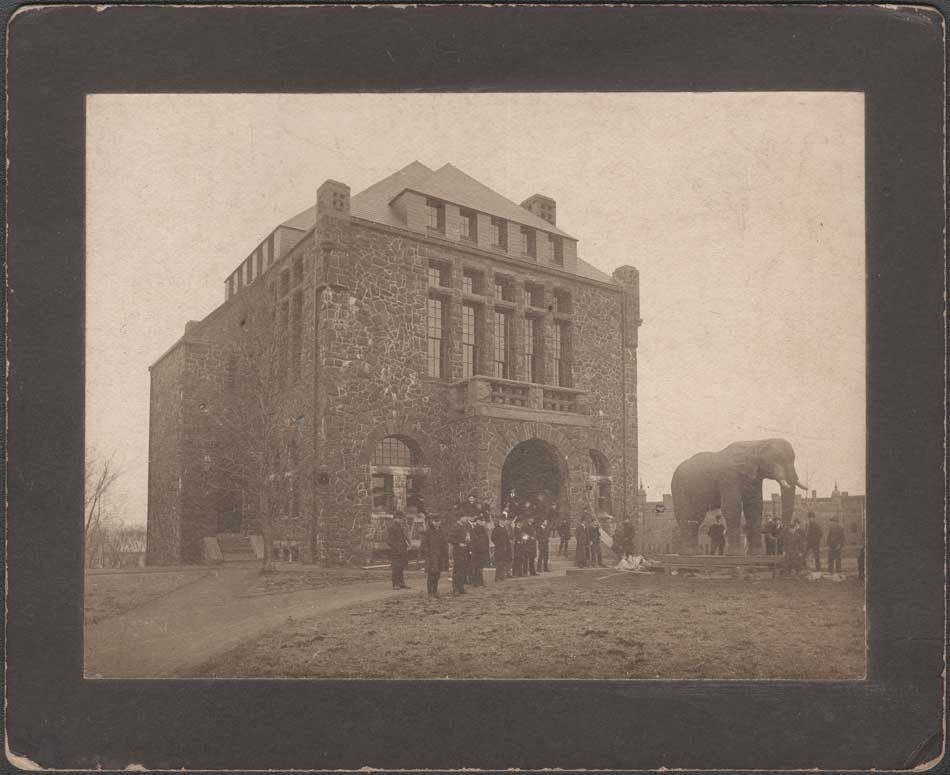 "Moving Jumbo into Barnum Museum, 1889" (assigned title by Tufts University Archives- see variant:ID: tufts:UA136.002.DO.00823 ): Attributed photographer: Charles Rollins Tucker, American (b. 1868): 1889: mounted brown-toned gelatin silver print on cabinet card: 8.3 x 11.0 cm | 10.8 x 13.2 cm. This rare photograph taken on April, 3 1889 posthumously shows the famed circus elephant Jumbo (died 1885) once owned by circus showman P.T. Barnum, now stuffed, sitting outside the Barnum Museum of Natural History on the Tufts College campus in Medford, Mass. before being placed on display. Vintage photograph from: PhotoSeed Archive.
"Moving Jumbo into Barnum Museum, 1889" (assigned title by Tufts University Archives- see variant:ID: tufts:UA136.002.DO.00823 ): Attributed photographer: Charles Rollins Tucker, American (b. 1868): 1889: mounted brown-toned gelatin silver print on cabinet card: 8.3 x 11.0 cm | 10.8 x 13.2 cm. This rare photograph taken on April, 3 1889 posthumously shows the famed circus elephant Jumbo (died 1885) once owned by circus showman P.T. Barnum, now stuffed, sitting outside the Barnum Museum of Natural History on the Tufts College campus in Medford, Mass. before being placed on display. Vintage photograph from: PhotoSeed Archive.
Picking up the Ashes
Jumbo has given back to Tufts, no pun intended, in a Huge way. Period accounts state he was immediately adopted as the school’s new mascot shortly after his arrival in 1889 and continues in that role today at Tufts University. The school website, semantics aside, brags Jumbo is the “only college mascot found in Webster’s Dictionary.” But alas, Jumbo endured a second death, this time by fire in 1975, when faulty wiring lead to a conflagration that gutted the 1884 Barnum museum. But all was not lost. Fortunately, the school’s archives held a section of Jumbo’s tail removed earlier because of students continual penchant for tugging on it, and a university staff member, while the rubble was still smoldering, had the smarts to scoop up some of his ashes that now reside in a Skippy peanut butter jar at the school. (nice trivia question- it’s secured with a Peter Pan Crunchy brand lid) Members of the sports teams on campus are said to rub this jar for good luck before an important game, and students indelible memories of college life at Tufts have been published every year since 1917 in the “Jumbo” yearbook.
With reporter Julien Edgerly’s account of a Tufts student photographer recording Jumbo for posterity in front of the museum on April 3, 1889, my argument and “Conclusive proof” Charles Rollins Tucker was that author working with Edgerly seems credible. For comparison, the Tufts archives holds a photograph dated 1889 showing Jumbo later on exhibit inside the museum credited to noted marine photographer N. L. Stebbins. (Nathaniel Livermore Stebbins-1847-1922) But given Jumbo’s immense fame, why is there no back-mark or other attribution for Stebbins for this exterior view of Jumbo? Surely, like one of his famous yachting studies, Stebbins would have insisted on it!
On his way to becoming a fine pictorialist photographer in the early 20th Century, Charles Tucker took a series of architectural photographs that survive in this archive which further gives credibility to his being responsible for the 1889 exterior Jumbo photograph. These include several examples seen above showing (ca. 1890-95) one of architect Henry Hobson Richardson’s masterpieces, the Thomas Crane Public Library (built 1882) located in Quincy, south of Boston. This is a gelatin silver mounted cabinet card using the same card-stock as the Jumbo photograph as well as a variant mounted cyanotype on a different paper stock. Finally, when he finished with his masters degree in late 1894 at Tufts, Tucker became sub-master until 1896 at Quincy High School- the same town as Richardson’s library. Two of his photographic views of this additionally survive, with a card-mounted, signed cyanotype by him dated 1896 seen here.
Notes:
1. excerpt: Step Right Up! : Bob Brooke presents the history of the circus in America : from: History Magazine: October/November 2001 issue: online version accessed March, 2015.
2. excerpt: Jumbo: by John R. Russell: in: University of Rochester Library Bulletin: vol. III, no. 1: Fall, 1947: River Campus Libraries online resource accessed March, 2015
3. Ibid
4. excerpt: Jumbo: Here and There at Tufts: Medford: Tufts College: Lewis Doane, Editor-in-chief: 1907: p. 44
5. excerpt: Jumbo: by John R. Russell: in: University of Rochester Library Bulletin: vol. III, no. 1: Fall, 1947: River Campus Libraries online resource accessed March, 2015
6. excerpt: Jumbo Matriculates: from: An Elephant’s Tale: Susan Wilson, J69, G75: Tufts online Magazine: Spring, 2002
7. The Boston Daily Globe: Thursday, April 4, 1889: p. 4
8. excerpt: Annual Report of the President of Tufts College: Boston: 1889: p. 36
This entry was posted on Sunday, March 29th, 2015 at 12:28am and is filed under New Additions, Significant Photographs. You can follow any responses to this entry through the RSS 2.0 feed.